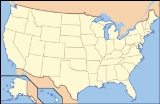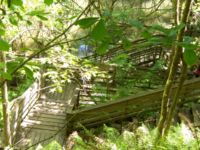
Devil's Millhopper Geological State Park
Encyclopedia

Florida State Parks
The Florida State Parks encompass the majority of the lands that fall under the authority of the Florida Department of Environmental Protection. There are 160 such entities, including nature reserves, recreation areas, and historic sites, which can be found in every corner of the state...
located north-westernmost part of Gainesville, Florida
Gainesville, Florida
Gainesville is the largest city in, and the county seat of, Alachua County, Florida, United States as well as the principal city of the Gainesville, Florida Metropolitan Statistical Area . The preliminary 2010 Census population count for Gainesville is 124,354. Gainesville is home to the sixth...
, off County Road 232, northwest of the University of Florida
University of Florida
The University of Florida is an American public land-grant, sea-grant, and space-grant research university located on a campus in Gainesville, Florida. The university traces its historical origins to 1853, and has operated continuously on its present Gainesville campus since September 1906...
.
The park is maintained by the Florida State Parks system, a division of the Florida Department of Environmental Protection
Florida Department of Environmental Protection
The Florida Department of Environmental Protection is the Florida government agency charged with environmental protection.-History:...
. The park is adjacent to San Felasco County Park, and near the San Felasco Hammock Preserve State Park
San Felasco Hammock Preserve State Park
San Felasco Hammock Preserve State Park is a Florida State Park in Alachua County, Florida. It is located northwest of Gainesville, Florida on CR 232 , just south of the town of Alachua.-Fauna:...
.
Geology
The cutaway, limestoneLimestone
Limestone is a sedimentary rock composed largely of the minerals calcite and aragonite, which are different crystal forms of calcium carbonate . Many limestones are composed from skeletal fragments of marine organisms such as coral or foraminifera....
sides of the sinkhole
Sinkhole
A sinkhole, also known as a sink, shake hole, swallow hole, swallet, doline or cenote, is a natural depression or hole in the Earth's surface caused by karst processes — the chemical dissolution of carbonate rocks or suffosion processes for example in sandstone...
provide an easily visible geological record of the area. Twelve springs
Spring (hydrosphere)
A spring—also known as a rising or resurgence—is a component of the hydrosphere. Specifically, it is any natural situation where water flows to the surface of the earth from underground...
, some more visible than others, feed the pond at the bottom of the sinkhole. In the summer, the bottom of the sinkhole is dramatically cooler than the air at the surface due to the depth and shade from the canopy above. Significant fossil deposits include shark teeth, marine shells, and the fossilized remains of extinct land animals.
Ecology
Even though the park is only 71 acres (287,327.1 m²), three distinct ecological environments exist in the park, based on exposure to sun, fire, and water. In the sandhillSandhill
A sandhill is a type of ecological community or xeric wildfire-maintained ecosystem. It is not the same as a sand dune. It features very short fire return intervals, one to five years. Without fire, sandhills undergo ecological succession and become more oak dominated.Entisols are the typical...
environment, the sandy soil and regular fires result in pine
Pine
Pines are trees in the genus Pinus ,in the family Pinaceae. They make up the monotypic subfamily Pinoideae. There are about 115 species of pine, although different authorities accept between 105 and 125 species.-Etymology:...
trees being the predominant vegetation. The moist soils of the hammocks
Hammock (ecology)
Hammocks are dense stands of hardwood trees that grow on natural rises of only a few inches higher than surrounding marshland that is otherwise too wet to support them. Hammocks are distinctive in that they are formed gradually over thousands of years rising in a wet area through the deposits of...
support broadleaf trees and more low vegetation, while the swamp
Swamp
A swamp is a wetland with some flooding of large areas of land by shallow bodies of water. A swamp generally has a large number of hammocks, or dry-land protrusions, covered by aquatic vegetation, or vegetation that tolerates periodical inundation. The two main types of swamp are "true" or swamp...
areas only support flora and fauna adapted to year-around wet conditions.
History
The 120 foot (40 m) deep, 500 foot (150 m) wide sinkholeSinkhole
A sinkhole, also known as a sink, shake hole, swallow hole, swallet, doline or cenote, is a natural depression or hole in the Earth's surface caused by karst processes — the chemical dissolution of carbonate rocks or suffosion processes for example in sandstone...
got its name from its similar appearance to the hopper
Hopper
Hopper may refer to:-Mechanical parts:* A general term for a chute with additional width and depth for temporary storage* Hopper , a large container used for dust collection* Part of a combine harvester...
of a mill
Mill (grinding)
A grinding mill is a unit operation designed to break a solid material into smaller pieces. There are many different types of grinding mills and many types of materials processed in them. Historically mills were powered by hand , working animal , wind or water...
, along with the bones found at the bottom, suggesting animals entered it on the way to meeting the devil
Devil
The Devil is believed in many religions and cultures to be a powerful, supernatural entity that is the personification of evil and the enemy of God and humankind. The nature of the role varies greatly...
. The site was purchased by the state in 1974, and a set of 232 wooden steps, along with boardwalks and an observation deck at the bottom were completed in 1976.

